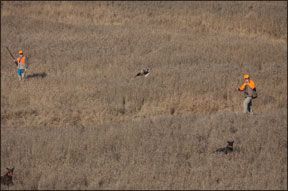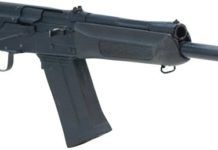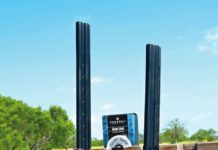One of the ongoing arguments between wingshooters is the 12 vs. 20 discussion. The short version of that issue can be summed up in two questions: Can I get away with the smaller gauge for the shooting I do?, or, Do I need the deeper and wider shotshell selection that the 12 gauge offers? One of the major reasons hunters choose a 20 over a 12 is the formers smaller frame, weight, and recoil. Though they may already own a 12, many field sportsmen wind up reaching for their 20s because the smaller gun is easier to handle, and there are just a few situations-layback goose hunting and spring turkey hunting, to name two-in which the bigger 12-gauge payload might make a difference.

Based solely on ballistics, its tough to make a case that the 20 gauge cant do most or all of the jobs the 12 gauge does. But thats not the whole story. There are certainly restrictions based on the 3-inch guns available for the two gauges. Looking at the major shotgun lines, Remington puts 3-inch chambers for both gauges its 11-87 Sportsman, Sportsman Camo, and Sportsman Synthetic lines, but it also doesnt chamber 20 gauges at all in its specialty guns for turkey, deer, and waterfowl, and some of the other 11-87s. Mossberg shunts its three 20-gauge models into the SA-20 line, offering no 20s in the 935 or 930 lines. In its vast selection of semiautos, Beretta offers just the AL391 Teknys Gold Sporting, AL391 Urika 2 Youth X-Tra Grain, and the 3901 Citizen Synthetic in 20 gauge. Available shotshell loads, too, show an overwhelming preference for the 12 gauge. Picking just one company to sample, Federal offers 65 12-gauge loads in its inventory, but only 21 20-gauge shot loads, a 3-to-1 edge.
So, even before we get rolling, the discussion of picking a 20 over a 12 for all-round use doesnt get much traction; there are just not enough 20-gauge shotguns and 20-gauge loads to make a 20 practical for use from woodcocks and snipe to Canadas and Merriams. But if we recast the argument to make it an upland comparison, then suddenly the playing field evens out.
Toward that end, we found two lightweight low-cost polymer-stocked shotguns from Weatherby and Escort we wouldnt mind schlepping around North Dakota to shoot pheasants. Our test guns were the SA-08 Synthetic from Paso Robles, Calif.-based Weatherby and the LSI/Hatsan Escort PS-20 HAT00115 3-inch 20 Gauge, $399 (price from Gallery of Guns online store).
The Escort Magnum 20-bore we tested was made by the Hatsan Arms Company in Izmir, Turkey and imported by Legacy Sports International of Reno, Nevada. LSI supplies a five-year warranty for the Escorts it imports, while Weatherby does not offer a written warranty on the SA-08.
Roy Weatherby introduced his first autoloading shotgun, the Centurion, in 1972 and it stayed in the lineup through 1975, when it was replaced by the Centurion II (1976-1981), which itself was supplanted by the Model 82 (1982-1989). Weatherby made a return to the semi-automatic market in 1999 with the SAS shotgun made by Valtro in Italy. The SAS was discontinued in 2007. The current lineup offers many choices, including the budget-priced SA-08, which is described as “a reliable workhorse that handles everything from early-season dove to late falls heaviest waterfowl loads. Injection-molded synthetic stock is tough enough to turn back the worst of conditions.” Just what we wanted.
Its also imported from Turkey, and Weatherby lists it at $469, but one of the companys online retailers, Gallery of Guns, lists the SA-08 No. SA08S1228PGM at $565, not including shipping or sales tax. Heres what our scattergunners thought of the pair:
Weatherby SA-08 Synthetic 3-Inch 12 Gauge, $565
Cleverly, the name identifies two aspects of this guns identity-its a Semi Auto introduced in 08. Besides the full-size Synthetics, there are several other sublines in the SA-08 category. The SA-08 Upland has a walnut stock with satin finish and matte black metalwork and sells for a $264 premium above the Synthetic-$733 on the Weatherby website. Theres also the $710 SA-08 Waterfowlers with camo finishes, a 20-gauge Synthetic Youth ($565), the SA-08 Deluxe ($754) in 12 and 20 gauge, and the $749 Entre Rios, named for the famous dove region of Argentina.
There are four Synthetic versions, two 12 gauges and two 20 gauges, all with 3-inch chambers and 28-inch or 26-inch barrels. Our test gun had a 28-inch chrome-lined barrel with an 0.3-inch-wide ventilated rib, the top of which had matte-crosshatch cuts to reduce glare. A 0.1-inch-wide brass front bead was staked into the front of the vent rib, which had no midbead, which we prefer. The matte-black aluminum alloy receiver and black composite stock reduced weight. Measuring 48 inches in overall length, our 12 gauge weighed 6.9 pounds unloaded, and the 20-gauge SA-08 Synthetic is said to weigh only 6 pounds.
Our test gun came plugged to a 2+1 capacity, appropriate for a game gun, and the shipping box contained three Multi-Choke tubes in Full, Modified, and IC constrictions. Internally, it had a chrome-plated bolt, a drop-out trigger group, and a dual-valve gas system, which we describe below. The stock had a 14.4-inch length of pull, 1.5 inches of drop at the comb, and 2.25 inches of drop at the heel. It had 3.2 inches of pitch, and we noticed about a half-inch of cast-on.
Operationally, the Weatherby SA-08 Synthetic features a dual-valve gas system that allows shooters to adapt the shotgun to accommodate the widest load ranges, the company claims, and its said to manage and reduce recoil compared to single-valve shotguns.
The gas-regulation system consists of two interchangeable valves, one labeled “Light Loads,” supposedly suitable for loads up to 11⁄8 ounces of shot, and a “Heavy Loads” valve to handle up to 3-inch magnum loads. The valves slide onto the magazine tube and fit into the barrel guide, where they regulate how much gas is allowed into the action system. Unfortunately, our gun arrived with only the Light Loads valve, so we had to borrow a Heavy Loads valve to conduct our testing. Changing valves took about a minute and involved unscrewing the fore-end cap, slipping off the forend toward the muzzle, slipping the barrel forward out of the action, pulling the valve off the front of the gas tube, installing the other valve, then pushing everything back together. It could be done in the field, our testers said, because no small parts or springs were involved. We also found the valves were easy to remove and clean.
We believe the SA-08s action is based on the Beretta A301 and looks very similar to the ALS 2100 shotgun from Traditions. At the time of the guns initial release, Brad Ruddell, Weatherbys vice president of sales and marketing, said, “With the addition of the dual valve system, our SA-08 semi-auto shotguns offer the widest range of load versatility. The first thing you notice when you pick one up is the trim look and light feel. Not noticeable, but still very important, is the fact that no other similar design of shotgun has been tested and refined as much as the Weatherby SA-08 Synthetic.”
When we surveyed the work of the ad-supported gun press, we found unanimity about the perfect function of the SA-08 with all loads. Our team cursed its bad luck, because were the only ones who seem to get malfunctioning guns.
We followed our standard test setup with the Weatherby, taking the owners manual from the box, reading it thoroughly, checking for parts (and noticing the Heavy valve was missing), field-stripping, lubricating, and cleaning the gun, then assembling and testing it with snap caps. Thats when we first noticed sluggishness in the receiver, so we worked the bolt several hundred times, but it didnt seem right.
During function testing at the range, we started with loads supposedly matched for the installed Light valve, starting with 12-gauge Remington ShurShot Target Loads (23⁄4-inch, 11⁄8 oz. No. 8 shot, 3 dr. eq., 1200 fps). Rounds wouldnt feed from the magazine into the chamber consistently, so we switched to Wolf (23⁄4-inch, 11⁄8 oz. No. 8 shot, 23⁄4 dr. eq., 1145 fps), then Winchester Super Handicap (23⁄4-inch, 11⁄8 oz. No. 8 shot, 1250 fps), then Winchester Light Target (23⁄4-inch, 11⁄8 oz. No. 8 shot, 23⁄4 dr. eq.), then Federal Steel Game & Target FRS12, (23⁄4-inch, 1 oz. No. 6 shot, 3.64 dr. eq., 1375 fps), and Federals Gold Medal Target International Paper N119 shells (23⁄4-inch, 7⁄8 oz./24 gram No. 71⁄2 shot, 3.15 dr. eq., 1325 fps). With the malfunction repeating, we swapped to the Heavy Load valve and reshot the light loads, but the malf persisted. This is actually what we expected, since the owners manual says that light loads might not function with the Heavy valve installed. So we bumped up to Remington Wingmaster HD (3 inch, 13⁄8 oz. No. 4 shot, 1200 fps) and Remington Premier Nitro-Steel (3 inch, 11⁄8 oz. No. 4 shot, max dr. eq., 1500 fps), but the problem persisted. Because shooting 3-inch magnums in a 6.5-pound gun isnt all that much fun, we resolved to load and shoot singles for the rest of the test, hoping that the gun would wear in, but it didnt. All in, about one round in 20 cycled the gun, for no apparent reason we could discover and fix.
We checked with Mr. Ruddell about the SA-08s performance, and he said, “If a consumer had ended up with this shotgun, we would request the gun back immediately, likely sending a UPS call tag for it to speed its return, for evaluation by our VP of engineering and senior QC specialist.
“We would research the serial number so that we could determine who had packed it, where it was shipped, and so on to attempt to determine why/how the second valve was missing.”
He added, “Our view is that rebutting Gun Tests experience with this shotgun would be secondary at this point. Weve had enough experience with the reviewers to know they are professional and more than capable. [Our first priority would be] getting the gun back for evaluation.
“Beyond that, it goes without saying we are disappointed and more than a little embarrassed that this shotgun performed so poorly,” Ruddell said, “but we look forward to finding out why, making the necessary repairs, replacement and/or design changes. We believe that when issues arise with our products, its our first opportunity to prove to the customer they still made the right choice.”
On the upside, the SA-08 Synthetic receiver included an easy-to-access drop-out trigger group that can be removed and reassembled for easy cleaning. Our team liked this feature a lot. Also, looking down the bore (with the barrel off the gun, of course), we saw chrome-lined barrels, and we gauged the presence of lengthened forcing cones. The screw-in Multi-Chokes are compatible with the Briley thread pattern, and the Weatherby came with three choke tubes and a big, plastic-handled wrench.
When we shot singles with the Weatherby, there were some other things our team noted about the SA-08. Some of our shooters complained the stock was too short, so they added a slip-on recoil pad. Also, the light gun kicked hard with 3-inch magnums, and it wasnt a joy to shoot with 23⁄4-inch Super Handicaps either. The slim shape of the forearm was well thought out, our testers said, because the groove just below the barrel could accommodate the thumb for a shooter who puts his pointing finger under the fore-end, or it felt just as natural to slip the pointing finger into the forearm groove and point alongside the barrel. It also featured a magazine cut-off lever so you can clear the chamber or change loads without emptying the magazine. Loading the gun was inconvenient, we thought. With an open action, wed drop one round in the receiver and press the bolt-release button, but it wouldnt slam forward until we pulled the bolt back slightly and took pressure off the release.
Our Team Said: We recognize that a single guns results dont necessarily describe how the entire line will function, but based on our test gun not being able to feed shells, we cannot recommend it. Is that our only beef? No. Weatherbys customer-service reputation is quite good, so lets assume our gun was repaired under warranty to our satisfaction. Would we then buy the SA-08 anyway? Again, no. Weve reviewed too many better synthetic semiautos that we would buy ahead of it, either new or used.
Some examples of similar high-ranked guns wed buy instead include the S&W M1012 (1109GT, A-), Stoeger 2000 12 Gauge No. 31515 (1006GT, Buy It), the Remington 11-87 12 Gauge No. 25289, (1006GT, Our Pick), or even Weatherbys SAS Field 12 Gauge (0706GT, Buy It). The SAS Weatherby is discontinued, so it would be a used-gun buy, but the SAS included a shim kit (like the Escort below) to make the stock fit better, and it had nary a misfeed in our test.
LSI/Hatsan Escort PS-20 HAT00115 3-inch 20 Gauge, $399
The Escort Magnum 20-bore we tested was made in Izmir, Turkey (about 200 miles southwest of Istanbul) by the Hatsan Arms Company and imported by Legacy Sports International of Reno, Nevada. LSI supplies a five-year warranty for the Escorts it imports.
Our test gun came with nickel-chrome-moly 26-inch barrels with a hard-chrome-plated bore and outside black chrome finish. The ventilated barrel rib was scored with C-shaped grooves along most of its length as a glare-killer, and the muzzle was threaded to accept screw-in choke tubes, and three (Full, Modified, and Improved Cylinder) came with the gun. Of course, the 3-inch magnum chamber and choke tubes for both guns were proofed for steel shot, and all sporting Escorts include sling-swivel studs, a choke-tube wrench, and migratory waterfowl plug. For a working gun, the studs were a helpful addition that the Weatherby lacked.
Examining the black-anodized aircraft-alloy receiver, we noted a trigger-guard button safety and a big grooved cut-off button for loading single rounds. The Weatherbys magazine cutoff was a small button-lever in front of the left-side trigger guard, and our testers opined that the Escorts was the better design. Milled into the top of the Escorts receiver was a 3⁄8-inch dovetail rib for accessory sights, which the Weatherby lacked. The gas-operated semiauto came with two stock-adjustment shims and three cushioned rubber recoil pads in what the company calls small, medium, and large girths. The Weatherby didnt have these. The Smart Valve Piston gas system is rated for 7⁄8-oz. to 2-oz. magnum shotloads, and didnt require changing valves to operate, unlike the Weatherby.
At just 6.25 pounds and 46 inches OAL, the gun weighs about right for a single-barrel 20 gauge that you carry in one hand while jogging behind pointing dogs, and the action and magazine tube contribute about 4 pounds of that total, or more than 40% of the guns total weight. The point of balance fell in line with the front edge of the aluminum alloy receiver. As on the Weatherby, the Escorts stock and fore-end were polymer, meaning they are strong, light, waterproof, and oilproof. The molded grip panels substituted for checkering and were very effective, our team said. The slender fore-end felt easy to hold and was long enough to accommodate both short- and long-leading-arm shooting styles. The as-delivered 14.25-inch LOP measured short for most shooters, but it was adjustable by replacing the buttpad, something the Weatherby lacked. The drop at the tip of the comb and heel of the right-handed stock measured 1.5 inches and 2.5 inches respectively, but they can be altered by the addition of drop spacers used either singly or as a pair. Our team said this gave the Escort a big edge over the SA-08, which lacked the feature.
The 26-inch Escort barrel accepts 3-inch magnums, as does the Weatherby, and we shot as little of them as we could, because those shells caused stiff recoil in the light gun. Slim and gently tapered, the 6mm-wide ventilated top-rib ended with a greenish light sight instead of a brass front bead. We found the green-plastic bead was easier to see in dingy light. Inside the gun, the bore was clean and well finished, and the breech extension was smooth.
Some of our shooters used to over/unders complained about the safeties on both guns-buttons near the trigger guard-as not feeling as natural as a tang safety.
Disassembly was uneventful. Before disassembling the shotgun, always make sure that the shotgun is not loaded, the barrel is pointed in a safe direction and the safety is On. With the bolt in the forward position unscrew (counter-clockwise) the fore-end cap. Remove the fore-end cap and from the magazine tube. Grasp the barrel and remove it from the stock-receiver-magazine tube assembly. With your fingers compress the bolt to align the two notches on the bolt where the cocking handle is attached. Then with your other hand pull the bolt cocking handle and remove it from the bolt. Remove the rubber O ring and gas piston out of the magazine tube by sliding them. Slide the bolt and the action bar forward and remove them from the magazine tube-receiver assembly. At this point, keep the bolt up to prevent it from falling away from the action bar. Reassembly in reverse is straightforward.
If you want to keep going and remove the trigger assembly, first punch the two pins out with a hammer, then press the carrier downward until the trigger assembly moves down, and then pull the trigger assembly downward using the trigger guard to remove it completely. If you want to take just the trigger assembly out, it can be done without first removing the barrel or bolt assembly.
There are five different screw-in chokes that can be used in the shotgun, but only three come as standard equipment. The tube body is labeled with the constriction, and the front edges are notched to designate their choke status (Full / ), (Modified /// ), (Improved Cylinder //// ). In both guns, the Modified and Improved Cylinder are good for steel shot. The Full Choke tube should be used with only lead shot. In both guns we shot and got IC-rated shot densities on Hunter John patterning targets, which we shot at 25 yards to try to counteract a stiff right-to-left wind. To no avail, because both guns had their patterns strongly shifted to the left.
One of the few complaints we had with the gun was the stockfit as delivered. But through a trial-and-error process, each shooter used the three buttpads and two stock shims to pretty much get the stockfit he wanted. To do that, we unscrewed the very tight buttplate screws and removed the recoil pad. To continue disassembly, then turn the nut in the hole in which the stock-connecting rod extends by means of a box spanner, and remove the stock connecting nut, spring washer, and the washer. Then, remove the stock from the stock connection rod. Assemble the stock drop spacer(s) and put the stock over the stock connection rod. Reassemble the stock-connecting nut, spring washer, and the washer. Then screw the buttplate screws to the end until the stock completely seats in its place.
Our Team Said: In this budget polymer-stock matchup, the Escort did one thing much better than the Weatherby SA-08: it functioned reliably. It also had several features lacking on the SA-08, such as sling swivels, a receiver milled to accept accessories, and a shim-adjustable stock. Weve tested several guns selling for a heckuva lot more that didnt include those amenities. Any way you shake it, for upland use this gun from Turkey aint no turkey.




























